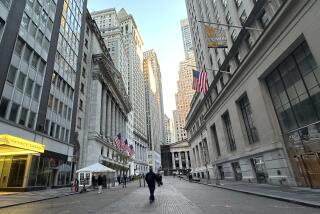Economic Indicators Rise in April to Calm Fears of Recession
- Share via
WASHINGTON — The government’s chief economic forecasting gauge shot up 0.8% in April as it reversed course after posting declines in the previous two months, the Commerce Department said today.
The upward turn in the index of leading economic indicators allowed the index to steer clear of the traditional signal of a forthcoming recession--three declines in a row.
The index, designed to foretell economic activity six to nine months into the future, had dropped a revised 0.6% in March and 0.3% in February.
Analysts said April’s upturn, which had been widely anticipated, was consistent with the view that while the economy is slowing, there still is enough strength left to power the record peacetime expansion through its seventh year.
“It wasn’t a good bet, it isn’t a good bet and it’s not going to be a good bet in the fall that a recession is about to occur,” economist James Annable of First National Bank of Chicago said in anticipation of today’s report.
Last month’s increase in the index was the biggest rise since a similar 0.8% jump in January.
Using the three-month rule of thumb for predicting recessions, the index has correctly forecast all eight economic downturns that have occurred since 1948, but it also has flashed false recession signals on five other occasions.
Most recently, the index declined five times in a row in the months surrounding the October, 1987, stock market crash, from which the economy emerged unscathed.
In April, eight of the 11 forward-looking business statistics that make up the composite index pointed upward, led by an increase in manufacturers’ orders for consumer goods.
Other indicators making positive contributions were rising building permits; a longer average workweek; higher stock prices; a decrease in initial claims for jobless benefits; slower vendor deliveries, signaling stronger demand; a gain in orders for new plants and equipment, and an increase in manufacturers’ unfilled orders.
3 Indicators Drop
Three indicators pointed downward: a drop in an index measuring consumer confidence; a contraction in the money supply, and falling prices for sensitive materials, indicating slower demand.
The various changes left the index at 145.7% of its 1982 base of 100. The index has advanced 1.3% over the last six months, contrasted with a 1.7% increase over the previous six-month period.
Annable said recent reports on the economy’s performance indicate that growth will slow to a more sustainable level and “suggest this economy is in better shape for growth than even we optimists thought.”
Pessimists are also rethinking their views.
Robert Dederick, chief economist for Northern Trust Co. in Chicago, has been forecasting a mild recession by year’s end but now concedes, “The odds are by no means convincing, even to me.
“The evidence is coming on the side of a soft landing--continued but subdued growth.”
That is just what the Federal Reserve has been trying to produce by nudging up interest rates.
Dederick said an upturn in the index “doesn’t mean that we should be looking for the economy to go roaring off, but it does weaken the case that the slowdown is going to develop into recession proportions.”
More to Read
Inside the business of entertainment
The Wide Shot brings you news, analysis and insights on everything from streaming wars to production — and what it all means for the future.
You may occasionally receive promotional content from the Los Angeles Times.










